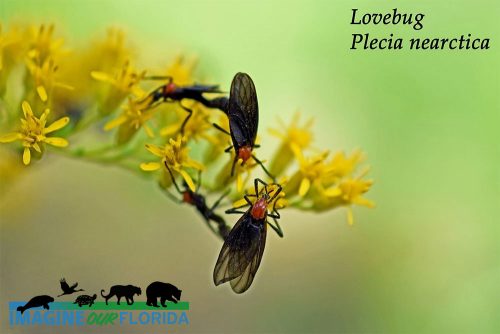The Lovebug (Plecia nearctica) is one species of insect that most everyone in Florida knows and can identify. But, do you know ABOUT this species? There is a lot of misinformation about this species. Additionally, apart from the “flights” that occur, most know nothing else about this species’ natural history.
Let’s start with the one huge myth about this species. they are NOT man-made insects created in a lab at the University of Florida. This is a pervasive myth that has circulated for decades. They are a non-native species in Florida. The first time they were documented in Florida was in 1947. They are found across the gulf coast and as far north as North Carolina.
In Florida, lovebugs can be found throughout the year. But, there are 2 big “flights” of lovebugs, when they occur in huge numbers across their range. As many already know, the first flight occurs in late spring in the months of April and May. The second flight occurs in late summer in the months of August and September.
The lovebug has some interesting reproduction behavior. When females emerge from the ground, they are met by swarms of males. The male will clasp a female in the air and the two will fall to the ground. When the males first connect with the female, the male and female are facing the same direction. Then, the male turns 180 degrees and remains that way for the duration of mating.
Large females lay an average of 350 eggs before they die. Adult lovebugs have a short lifespan with females living up to 7 days and males up to 5 days. The eggs hatch in 2 to 4 days. The larva feeds on decomposing vegetation in moist, grassy areas such as pastures. In this way, they are extremely helpful in converting decaying vegetative matter into organic matter.
The adults feed on the nectar of numerous species, particularly sweet clover, Brazilian pepper, and the goldenrod seen in these photos.
There are few predators of the adult stage of lovebug as their slightly acidic insides make them unpalatable. The larva is food for birds such as robins and quail as well as spiders, earwigs, and other insect predators.
They do not bite or sting, but they are considered a pest species. The huge flights often occur near roadways and interstates (think of all the moist grass of cow pastures and roadsides which is a wonderful home for larva). It also appears that the bugs are drawn to the exhaust of cars. It has been proposed that the chemicals in car exhaust, aldehydes, and formaldehyde, are similar to the chemicals released by decaying organic matter. This means that lovebugs think they are hovering over a great spot to lay their eggs. Older car paints used to be damaged by the acidic internal organs of the lovebug, however, they do not have the same effect on new cars. Lovebugs can be very difficult to remove from the fronts of cars after the bodies dry and can clog radiators.
Love Bug Season usually occurs during May and September. Love Bugs (Plecia nearctica), are not a genetic experiment. They are actually a small black fly, with a velvet-looking appearance and a red area on the back of the head.
Love Bugs were not created and released by the University of Florida to control mosquitos. They do not eat mosquitoes. They are nectar drinkers and pollinators. They feed on Brazilian Pepper, sweet clover, and goldenrod. Adult Love Bugs do not eat at all.
Love Bugs are an invasive species from South America and have been in Florida since the 1940s. They are attracted by car exhaust, lawnmowers, other engines, and heat. The white splat on your car is their eggs. Love Bugs do not bite, sting, or transmit diseases.
Love Bugs serve an important ecological role in Florida. Their larvae convert plant material into organic components which growing plants recycle for food. Love Bugs live between 3 to 4 days.
Female Love Bugs lay between 100 to 350 irregular-shaped, gray eggs on decaying topsoil material such as cut grass or thatch. Once the eggs hatch the larvae will live and feed in the organic material until they turn into a pupa. The larvae are gray with a darker head. They will stay in the larvae stage between 120 to 240 days depending on the season. They are in the pupa stage 7-9 days. Mating takes place right away once they emerge as adults. The male emerges first then waits for the female. Females fly into the swarming males. Once the adults copulate they will remain joined until the female is fertilized. The male stays attached to the female to prevent another male from fertilizing her. This takes 2-3 days, then the female detaches, lays her eggs, and dies.
Remember, if the University of Florida had created Love Bugs, they would be orange and blue, not black and red. : )
Photo Credit: Andy Waldo

